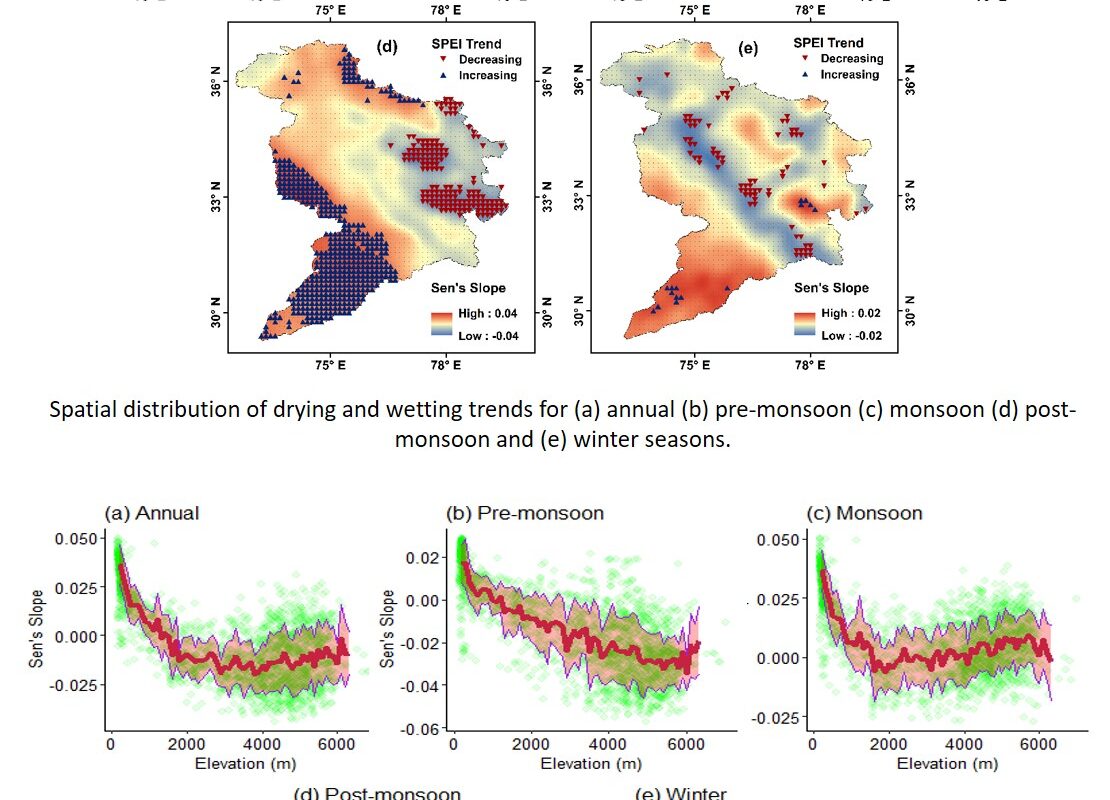IIT Mandi Researchers Uncover the Relationship between Drought Occurrence and Altitudinal Variation in the Indus River Basin

by Prashant Kapadia/NHN
Researchers used meteorological parameters to understand the connection between elevation and drought occurrence in the Indus River Basin
The study reveals a strong correlation between elevation and drought, with wetting trends observed in low-lying areas and drying trends prevalent in the highlands
Understanding the impact of elevation on drought is important for effective drought risk assessment and water management
Video Byte – https://drive.google.com/file/d/1MR6E56MW1uT7qzOp7q1zV7RSi7ZzwPmJ/view
Mandi, 13th June 2023: Indian Institute of Technology Mandi researchers have studied the relationship between the elevation and the drought characteristics. The study, centred on the Indus River basin in India, provides valuable insights into water management and climate adaptation strategies for this region.
These findings have been published in the journal Atmospheric Research in a paper co-authored by Dr. Deepak Swami, Associate Professor, School of Civil and Environmental Engineering, IIT Mandi, Dr. Vivek Gupta, Assistant Professor, School of Civil and Environmental Engineering, IIT Mandi and Dr. Nitin Joshi from Department of Civil Engineering, IIT Jammu along with their Ph. D scholar Mr. Amit Dubey from IIT Mandi.
With the exponential increase in population, there is growing demand for water, but limited availability. This, coupled with global climate change and extreme water-related events like floods and drought, poses a threat to human society.
While highlighting the importance of understanding drought trends with respect to elevation, Dr. Deepak Swami, IIT Mandi, said, “According to a report by India’s Ministry of Earth Sciences, the period from 1951 to 2016 witnessed an increase in the frequency of droughts in India, with more than 2 droughts per decade in many areas. Understanding drought dynamics is therefore crucial for effective water management and planning.”
High-altitude regions are particularly sensitive to the effects of climate change, like droughts. Analysing the relationship between drought trends and elevation across different time scales can help predict droughts and frame policies to mitigate their effects.
IIT Mandi researchers have focused on the Indus River basin. This basin holds immense importance in terms of agricultural productivity and water supply in the Indian subcontinent. Furthermore, the wide range of elevations within the basin, ranging from 93 to 8,489 meters, provides an ideal setting to explore the connection between elevation and drought characteristics.
The research team employed statistical techniques using extensive data on monthly precipitation, and maximum and minimum temperatures spanning 42 years (1979–2020) to study drought patterns. The drought quantification was done using a drought indicator based on climatic water balance, which is integral to understand droughts.
Speaking about their research, Dr. Vivek Gupta, IIT Mandi, said, “We saw a strong correlation between drought and elevation. Areas below 2,000 meters experienced wetting trends, while altitudes between 2,000 and 6,000 meters showed drying trends. However, elevations above 4,000 meters had a slower rate of drying.”
Furthermore, the research findings highlighted the significant heterogeneity in drought trends across different seasons. Monsoon and post-monsoon seasons experienced larger areas with wetting trends, while the pre-monsoon season saw a larger area with drying trends. Notably, extreme drought frequencies in the study region ranged from 0% to 5% from 1979–2020. Ultimately, the findings of the study point towards dryness of the region at higher altitudes whereas wetting is associated with lower elevations.
These insights hold particular importance for India, as rain-fed agriculture is prevalent in the highlands of the Indus River basin. The topography of the region restricts water storage and proper irrigation infrastructure, making it vulnerable to water scarcity and decreasing crop yields during dry periods. Understanding the effect of elevation on meteorological variables is crucial for effective policy formulation to mitigate the negative impacts of drought.
About IIT Mandi : IIT Mandi has nine Academic Schools and five major Research Centers. The Schools are the School of Biosciences and Bioengineering (SBBE), School of Chemical Sciences (SCS), School of Mathematical and Statistical Sciences (SMSS), School of Physical Sciences (SPS), School of Mechanical and Materials Engineering (SMME), School of Civil and Environmental Engineering (SCENE), School of Computing and Electrical Engineering (SCEE), School of Humanities and Social Sciences (SHSS), and School of Management (SOM). The Centers are Advanced Materials Research Centre (AMRC), Centre for Design and Fabrication of Electrical Devices (C4DFED), BioX Centre, Indian Knowledge System and Mental Health Applications Centre (IKSMHA Centre) and Centre for Artificial Intelligence and Robotics.
The Institute offers B.Tech. programs in seven different streams, one M.A. program, ten M.Tech. programs, nine Ph.D. programs, and one iPh.D. program. The unique, project-oriented B.Tech. curriculum is centered around its 4-year long Design and Innovation stream. Since the inception of the Institute, IIT Mandi faculty have been involved in over 275 Research and Development (R&D) projects worth more than Rs. 120 crores.
IIT Mandi established the IIT Mandi iHub and HCI Foundation (iHub; a section-8 company) on its campus at Kamand with significant funding of INR 110 crores from the Department of Science and Technology (DST), Government of India. The iHub is planned to fuel research and technology development, skill development, startup and innovation, and collaborations in the HCI and allied AI/ML areas in India. IIT Mandi is the only second-generation IIT to be featured at rank 7 in the Atal Ranking of Institutions on Innovation Achievements of the Innovation Cell, Ministry of Education, Govt. of India.
Previous Article
